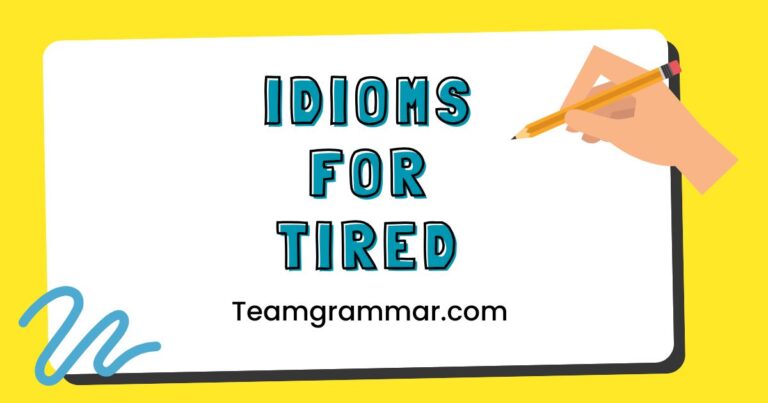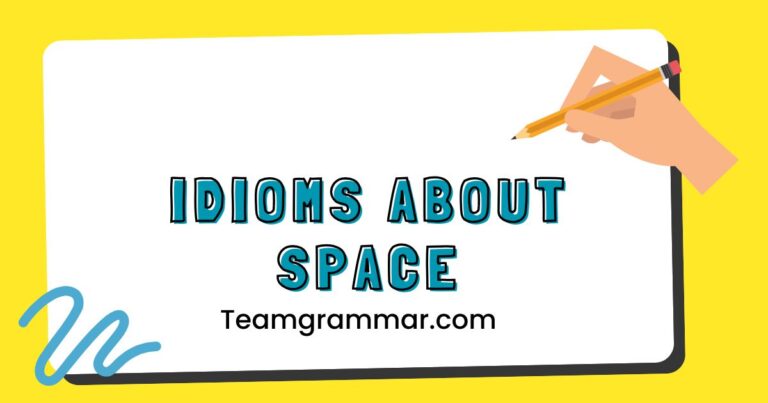43 Idioms for “Simple”: Mastering Everyday English Expressions
Idioms add color and depth to the English language, allowing native speakers to convey complex ideas with concise and evocative phrases. When describing something as “simple,” a plethora of idioms offer nuanced alternatives that go beyond the literal meaning.
Understanding these idioms is crucial for achieving fluency and comprehending the subtle undertones of everyday conversations and written texts. This article explores a comprehensive collection of idioms that express simplicity, providing definitions, examples, usage rules, and practice exercises.
This guide is perfect for English language learners looking to enhance their vocabulary, as well as advanced speakers aiming to refine their command of idiomatic expressions.
Table of Contents
- Introduction
- Definition of Idioms for “Simple”
- Structural Breakdown of Idioms
- Types and Categories of Idioms for “Simple”
- Examples of Idioms for “Simple”
- Usage Rules for Idioms
- Common Mistakes with Idioms
- Practice Exercises
- Advanced Topics in Idioms
- FAQ Section
- Conclusion
Introduction
English is rich with idioms, those colorful expressions whose meanings can’t be deduced from the literal definitions of their individual words. When we want to describe something as “simple,” we have a multitude of idioms at our disposal, each adding a slightly different shade of meaning.
From “a piece of cake” to “plain sailing,” these idioms offer engaging alternatives to the straightforward adjective. Mastering these expressions not only enhances your understanding of English but also allows you to communicate more effectively and naturally.
This article aims to provide a comprehensive guide to idioms that convey the concept of simplicity. Whether you’re a beginner or an advanced learner, you’ll find valuable insights into the meanings, usages, and nuances of these expressions.
By exploring examples, usage rules, and practice exercises, you’ll gain the confidence to incorporate these idioms into your everyday conversations and writing.
Definition of Idioms for “Simple”
An idiom is a phrase or expression whose meaning cannot be understood from the ordinary meanings of its individual words. It is a figure of speech that relies on a cultural understanding shared by native speakers.
In the context of describing something as “simple,” idioms offer a more vivid and nuanced way to express ease, lack of complexity, or straightforwardness. These idioms often draw on metaphors, similes, and other figurative language to convey their meaning.
Idioms for “simple” can be categorized based on the specific aspect of simplicity they highlight. Some emphasize ease of execution, such as “a walk in the park” or “easy as pie.” Others focus on the lack of complication, like “cut and dried” or “black and white.” Understanding these subtle differences is key to using idioms accurately and effectively.
Classification of Idioms for “Simple”
Idioms for “simple” can be classified into several categories based on the specific nuance they convey:
- Ease of Execution: These idioms emphasize how easy something is to do. Examples include “a piece of cake,” “easy as pie,” and “a walk in the park.”
- Lack of Complexity: These idioms highlight the absence of complications or difficulties. Examples include “cut and dried,” “black and white,” and “plain sailing.”
- Straightforwardness: These idioms suggest that something is direct and uncomplicated. Examples include “in a nutshell,” “the long and short of it,” and “to get to the point.”
- Obviousness: These idioms imply that something is very clear and easy to understand. Examples include “clear as day” and “plain as the nose on your face.”
Function of Idioms for “Simple”
The primary function of these idioms is to replace the simple adjective “simple” with a more expressive and engaging alternative. They add color and personality to language, making it more interesting and memorable.
Furthermore, using idioms correctly demonstrates a strong command of the English language and enhances communication skills.
Contexts for Using Idioms for “Simple”
Idioms for “simple” can be used in a variety of contexts, including:
- Everyday conversations: To describe tasks, situations, or concepts that are easy to understand or accomplish.
- Writing: To add flair and avoid repetitive language in essays, articles, and stories.
- Presentations: To make complex ideas more accessible and engaging for the audience.
- Informal communication: In emails, messages, and social media posts to convey a sense of ease and familiarity.
Structural Breakdown of Idioms
Idioms, by their nature, defy typical grammatical analysis. Their meaning is not derived from the individual words but rather from the entire phrase as a unit.
Therefore, a structural breakdown focuses less on traditional grammatical elements and more on the common patterns and figurative devices used in these expressions.
Many idioms for “simple” employ metaphors, comparing the task or concept to something inherently easy or uncomplicated. For example, “a piece of cake” uses the metaphor of eating cake to represent an easy task.
Similarly, “plain sailing” uses the image of a smooth, unobstructed journey by sea to convey the idea of an easy process.
Understanding these underlying metaphors and figurative devices can help learners grasp the meaning of idioms more intuitively. It also allows them to appreciate the creativity and expressiveness of the English language.
Metaphorical Elements in Idioms
Many idioms for “simple” rely heavily on metaphors to convey their meaning. Recognizing these metaphors can aid in understanding and remembering the idiom.
- “A piece of cake”: Eating cake is generally considered an enjoyable and easy activity.
- “Easy as pie”: Similar to “a piece of cake,” making or eating pie is often seen as a simple task.
- “A walk in the park”: Walking in a park is usually a relaxed and effortless activity.
- “Plain sailing”: Sailing on calm waters with favorable winds implies a smooth and easy journey.
Common Patterns in Idioms
While idioms are not strictly bound by grammatical rules, some common patterns emerge in their structure:
- Similes: Some idioms use similes (comparisons using “like” or “as”) to emphasize simplicity. For example, “as easy as ABC” compares something to the simplicity of the alphabet.
- Figurative Language: Idioms often employ figurative language such as hyperbole (exaggeration) or understatement to create emphasis.
- Fixed Expressions: Idioms are typically fixed expressions, meaning their word order and form cannot be changed without altering or losing their meaning.
Types and Categories of Idioms for “Simple”
Idioms for “simple” can be categorized based on the specific aspect of simplicity they emphasize. This categorization helps in understanding the nuances of each idiom and using them appropriately in different contexts.
Idioms Emphasizing Ease of Execution
These idioms highlight how easy something is to do or accomplish. They often use metaphors of enjoyable or effortless activities to convey this sense of ease.
- A piece of cake: Extremely easy.
- Easy as pie: Very easy.
- A walk in the park: Very easy and enjoyable.
- Child’s play: Something very easy to do, like a task a child could accomplish.
- No-brainer: Something that requires little or no thought.
Idioms Emphasizing Lack of Complexity
These idioms focus on the absence of complications or difficulties. They often use imagery of clarity and straightforwardness to convey this sense of simplicity.
- Cut and dried: Decided or settled and not likely to be changed.
- Black and white: Clear and easily understandable; involving a simple choice between two opposing things.
- Plain sailing: Easy and without problems.
- Straightforward: Easy to understand or simple.
- Uncomplicated: Not complex or difficult.
Idioms Emphasizing Straightforwardness
These idioms suggest that something is direct, uncomplicated, and to the point. They often emphasize the absence of ambiguity or hidden meanings.
- In a nutshell: In the fewest possible words.
- The long and short of it: The essence of the matter.
- To get to the point: To speak directly about something without avoiding the issue.
- To call a spade a spade: To speak frankly and directly, even if it’s unpleasant.
- No beating around the bush: To speak directly without trying to avoid the issue.
Idioms Emphasizing Obviousness
These idioms imply that something is very clear, apparent, and easy to understand. They often use visual metaphors to convey the sense of clarity and obviousness.
- Clear as day: Very easy to see or understand.
- Plain as the nose on your face: Very obvious.
- Crystal clear: Extremely clear and easy to understand.
- As plain as day: Very obvious.
- Written all over (someone’s) face: Very obvious from someone’s expression.
Examples of Idioms for “Simple”
This section provides extensive examples of idioms for “simple,” organized by category. Each example is accompanied by a sentence illustrating its usage and meaning.
These examples will help you understand how to use these idioms correctly and effectively in different contexts.
Examples: Ease of Execution
The following table provides examples of idioms that describe something as easy to execute.
| Idiom | Meaning | Example Sentence |
|---|---|---|
| A piece of cake | Extremely easy. | “The exam was a piece of cake; I finished it in half the time.” |
| Easy as pie | Very easy. | “Learning to ride a bike is easy as pie once you get the hang of it.” |
| A walk in the park | Very easy and enjoyable. | “For her, presenting to the board is a walk in the park.” |
| Child’s play | Something very easy to do. | “Fixing the computer was child’s play for the experienced technician.” |
| No-brainer | Something that requires little or no thought. | “Accepting the job offer was a no-brainer; it was perfect.” |
| As easy as ABC | Very easy and basic. | “Learning the basics of cooking is as easy as ABC with the right instructions.” |
| A cinch | Very easy. | “Getting tickets to the concert was a cinch thanks to my friend’s connections.” |
| A snap | Very easy. | “Baking these cookies is a snap, even for beginners.” |
| Like taking candy from a baby | Extremely easy and unfair. | “Beating him in chess was like taking candy from a baby.” |
| A breeze | Very easy to do. | “The project was a breeze because we had a great team.” |
| A cakewalk | Very easy to do. | “The interview was a cakewalk; the questions were straightforward.” |
| Plain sailing | Easy and without problems. | “Once we got the initial funding, it was plain sailing for the rest of the project.” |
| A lead-pipe cinch | Absolutely certain and easy. | “Winning the game was a lead-pipe cinch once their star player got injured.” |
| Falling off a log | Extremely easy to do. | “For a professional musician, playing that song is like falling off a log.” |
| Simple as that | Very easy and straightforward. | “Just press the button, and it’s fixed—simple as that.” |
| A doddle | Very easy to do. | “The test was a doddle; I finished it in record time.” |
| A pushover | Easy to influence or defeat. | “The opposing team was a pushover; we won easily.” |
| A gift | Something that is easy to do because of natural talent. | “She has a gift for languages; learning new ones is easy for her.” |
| All beer and skittles | Easy and enjoyable. | “Life isn’t all beer and skittles; sometimes you have to work hard.” |
| A snip | Easy to obtain or achieve. | “Getting the promotion was a snip because of my experience.” |
| Like clockwork | Happening in a regular and predictable way. | “The project ran like clockwork from start to finish.” |
| Like shooting fish in a barrel | Extremely easy and unfair. | “Winning against the inexperienced team was like shooting fish in a barrel.” |
Examples: Lack of Complexity
The following table provides examples of idioms that describe something as lacking complexity.
| Idiom | Meaning | Example Sentence |
|---|---|---|
| Cut and dried | Decided or settled and not likely to be changed. | “The contract was cut and dried; there was no room for negotiation.” |
| Black and white | Clear and easily understandable. | “The rules are black and white; there’s no ambiguity.” |
| Straightforward | Easy to understand or simple. | “The instructions were straightforward; I followed them without any problems.” |
| Uncomplicated | Not complex or difficult. | “The recipe is uncomplicated; even a beginner can make it.” |
| Simple | Easy to understand, do, or use. | “The solution to the problem was surprisingly simple.” |
| Elementary | Simple and basic. | “The concepts in the first chapter are elementary.” |
| Bare bones | Basic and without extra features. | “The website has a bare bones design, focusing on essential information.” |
| No frills | Simple and basic, without unnecessary features. | “The hotel is no frills, but it’s clean and comfortable.” |
| Basic | Simple and fundamental. | “The course covers the basic principles of accounting.” |
| Rudimentary | Limited to the basic principles. | “He has a rudimentary understanding of the subject.” |
| Down-to-earth | Practical and simple. | “She has a down-to-earth approach to problem-solving.” |
| Paint by numbers | Very simple and requiring little skill. | “The project was essentially paint by numbers; there was no creativity involved.” |
| A snap | Easy to do. | “With the new software, managing the data is a snap.” |
| Easy-peasy | Very easy. | “The task was easy-peasy; I finished it in no time.” |
| No sweat | No problem; easy. | “Don’t worry about the deadline; it’s no sweat.” |
| A piece of old tackle | Simple and easy to do. | “Repairing the fence was a piece of old tackle for him.” |
| One-horse town | Simple, unsophisticated place. | “The town is a bit of a one-horse town, but it has its charm.” |
| Milk run | Routine and simple task. | “The delivery was a milk run; everything went smoothly.” |
| Low-hanging fruit | Easy to achieve or obtain. | “Focus on the low-hanging fruit first to get quick results.” |
| Duck soup | Very easy to do. | “The assignment was duck soup for the experienced students.” |
| Vanilla | Ordinary and lacking excitement. | “The design was vanilla; it needed more creativity.” |
| Cookie-cutter | Uniform and lacking originality. | “The houses in the neighborhood are cookie-cutter; they all look the same.” |
Examples: Straightforwardness
The following table provides examples of idioms that describe something as straightforward.
| Idiom | Meaning | Example Sentence |
|---|---|---|
| In a nutshell | In the fewest possible words. | “In a nutshell, the project was a success.” |
| The long and short of it | The essence of the matter. | “The long and short of it is, we need to cut costs.” |
| To get to the point | To speak directly about something. | “Let’s get to the point; we need to make a decision.” |
| To call a spade a spade | To speak frankly and directly. | “Let’s call a spade a spade; the project is failing.” |
| No beating around the bush | To speak directly without trying to avoid the issue. | “No beating around the bush; we need to address this problem immediately.” |
| Straight from the shoulder | Direct and honest. | “He gave me advice straight from the shoulder.” |
| Cutting to the chase | Getting straight to the important part. | “Cutting to the chase, we need more funding.” |
| Point blank | Direct and without hesitation. | “He asked me point blank if I was happy with my job.” |
| Upfront | Honest and straightforward. | “He was very upfront about the challenges of the project.” |
| Above board | Honest and legal. | “The deal was completely above board; there were no hidden issues.” |
| On the level | Honest and genuine. | “You can trust him; he’s on the level.” |
| To lay it on the line | To speak frankly and directly. | “I had to lay it on the line and tell him the truth.” |
| To spell it out | To explain something very clearly. | “I had to spell it out for him before he understood.” |
| In plain English | In simple and easy-to-understand language. | “Can you explain it in plain English?” |
| To give it to (someone) straight | To tell someone the truth directly. | “I decided to give it to him straight and tell him what I really thought.” |
| To be blunt | Speaking directly without trying to be polite. | “To be blunt, your work isn’t good enough.” |
| To be frank | Speaking openly and honestly. | “To be frank, I don’t agree with your decision.” |
| To mince no words | To speak directly and clearly. | “He minced no words when he criticized the project.” |
| To speak one’s mind | To express one’s thoughts directly. | “He always speaks his mind, no matter what.” |
| To tell it like it is | To describe something honestly. | “He always tells it like it is, even if it’s not what you want to hear.” |
| To be on the up and up | Honest and trustworthy. | “You can trust him; he’s on the up and up.” |
| To not pull any punches | To speak directly and forcefully. | “He didn’t pull any punches when he criticized the performance.” |
Examples: Obviousness
The following table provides examples of idioms that describe something as obvious.
| Idiom | Meaning | Example Sentence |
|---|---|---|
| Clear as day | Very easy to see or understand. | “The answer was clear as day; I don’t know why I didn’t see it before.” |
| Plain as the nose on your face | Very obvious. | “The solution was plain as the nose on your face; I was just overthinking it.” |
| Crystal clear | Extremely clear and easy to understand. | “The instructions were crystal clear; there’s no room for confusion.” |
| As plain as day | Very obvious. | “It was as plain as day that she was lying.” |
| Written all over (someone’s) face | Very obvious from someone’s expression. | “Her disappointment was written all over her face.” |
| Stands out like a sore thumb | Very noticeable and obvious. | “His bright outfit stood out like a sore thumb in the crowd.” |
| As clear as mud | Not clear at all; confusing (ironic usage). | “The explanation was as clear as mud; I still don’t understand.” |
| A dead giveaway | Something that clearly reveals a secret. | “His nervousness was a dead giveaway that he was lying.” |
| No brainer | Obvious and requiring little thought. | “Hiring her was a no brainer; she was the best candidate.” |
| Like a beacon | Very noticeable and clear. | “The lighthouse shone like a beacon in the dark.” |
| Leaps to the eye | Immediately noticeable. | “The error leaps to the eye; it’s very obvious.” |
| Easy to spot | Easy to notice or identify. | “The mistake was easy to spot once you knew what to look for.” |
| A giveaway | Something that reveals information unintentionally. | “His hesitation was a giveaway that he was hiding something.” |
| Staring (someone) in the face | Very obvious and directly in front of someone. | “The answer was staring me in the face, but I didn’t see it.” |
| Obvious as can be | Extremely obvious. | “It was obvious as can be that they were in love.” |
| A no-brainer | Something that requires little thought because it’s obvious. | “Taking the job was a no-brainer, the pay was amazing!” |
| Plain sight | Easily visible. | “The keys were in plain sight, but I still couldn’t find them.” |
| Stick out a mile | Very obvious or noticeable. | “His lie stuck out a mile; it was so unconvincing.” |
| Bells and whistles | Obvious and showy. | “The new features are just bells and whistles; they don’t add much value.” |
| As clear as a bell | Very clear and distinct. | “Her voice was as clear as a bell, even from the back of the room.” |
| Couldn’t be more obvious | Extremely obvious. | “It couldn’t be more obvious that he’s trying to impress her.” |
| Easy to see | Simple to understand or notice. | “It’s easy to see why she’s so successful.” |
Usage Rules for Idioms
Using idioms correctly requires understanding their specific meanings and contexts. While idioms can add color and expressiveness to your language, using them inappropriately can lead to confusion or miscommunication.
Here are some key rules to follow when using idioms for “simple”:
- Understand the Meaning: Always ensure you fully understand the meaning of an idiom before using it. Using an idiom incorrectly can change the intended message.
- Consider the Context: Idioms are often context-dependent. Some idioms are more appropriate in informal settings, while others are suitable for formal situations.
- Avoid Overuse: While idioms can enhance your language, overuse can make your writing or speech sound unnatural. Use them sparingly and strategically.
- Maintain Consistency: Do not mix idioms or change their wording. Idioms are fixed expressions, and altering them can render them meaningless.
- Be Aware of Cultural Differences: Idioms are culturally specific. What is a common idiom in one culture may be unfamiliar or nonsensical in another.
Exceptions to Idiom Usage
While idioms generally follow fixed structures, there are some exceptions and variations to consider:
- Slight Variations: Some idioms may have slight variations in wording without significantly altering their meaning. However, it’s best to stick to the standard form unless you are certain of the variation.
- Figurative vs. Literal: Be mindful of the difference between the figurative (idiomatic) and literal meanings of words. Using an idiom literally can lead to misunderstandings.
Common Mistakes with Idioms
One of the biggest challenges in learning idioms is avoiding common mistakes. These mistakes often arise from misunderstanding the idiom’s meaning, misusing its structure, or applying it in an inappropriate context.
Here are some common errors and how to correct them:
- Misunderstanding the Meaning: Using an idiom with a completely incorrect understanding of its meaning.
- Literal Interpretation: Interpreting an idiom literally instead of understanding its figurative meaning.
- Incorrect Word Order: Changing the fixed word order of an idiom.
- Mixing Idioms: Combining elements of different idioms.
- Inappropriate Context: Using an idiom in a context where it doesn’t fit.
Now, let’s delve into some specific examples of common mistakes and their corrections.
| Incorrect | Correct | Explanation |
|---|---|---|
| “The test was a cake of piece.” | “The test was a piece of cake.” | Incorrect word order. The correct idiom is “a piece of cake.” |
| “That’s as clear as water.” | “That’s as clear as day.” | Using a similar but incorrect comparison. The correct idiom is “clear as day.” |
| “He was beating around the tree.” | “He was beating around the bush.” | Misunderstanding the metaphor. The correct idiom is “beating around the bush.” |
| “It was a walk in the home.” | “It was a walk in the park.” | Substituting a word with a similar one. The correct idiom is “a walk in the park.” |
| “She called the shovel a shovel.” | “She called a spade a spade.” | Using the wrong noun in the idiom. The correct idiom is “call a spade a spade.” |
Practice Exercises
Testing your understanding is crucial to mastering idioms. Here are several practice exercises to help you reinforce your knowledge of idioms for “simple.”
Exercise 1: Fill in the Blanks
Complete the following sentences with the appropriate idiom from the list below.
Idiom List: A piece of cake, easy as pie, a walk in the park, cut and dried, clear as day, in a nutshell
| Question | Answer |
|---|---|
| 1. The instructions were __________, so I had no trouble assembling the furniture. | clear as day |
| 2. The exam was __________, I finished it in record time. | a piece of cake |
| 3. The agreement was __________, there was no room for negotiation. | cut and dried |
| 4. Learning to bake a cake is __________ once you have the recipe. | easy as pie |
| 5. For her, public speaking is __________. | a walk in the park |
| 6. __________, the project was a complete success. | In a nutshell |
| 7. Solving this puzzle is __________, even for beginners. | a piece of cake |
| 8. The decision was __________, with no further discussion needed. | cut and dried |
| 9. Understanding the concept is __________, once you grasp the basics. | easy as pie |
| 10. Planning the event was __________, given her extensive experience. | a walk in the park |
Exercise 2: Match the Idiom to its Meaning
Match each idiom with its correct meaning.
| Idiom | Meaning |
|---|---|
| 1. No-brainer | a. Very easy and enjoyable |
| 2. Plain sailing | b. Very obvious |
| 3. A walk in the park | c. Requiring little or no thought |
| 4. Plain as the nose on your face | d. Easy and without problems |
Answers:
- 1 – c
- 2 – d
- 3 – a
- 4 – b
Exercise 3: Correct the Sentence
Identify and correct the incorrect use of idioms in the following sentences.
| Incorrect Sentence | Correct Sentence |
|---|---|
| 1. The task was a cake of piece for him. | The task was a piece of cake for him. |
| 2. It’s clear as water that he is lying. | It’s clear as day that he is lying. |
| 3. Let’s cut to the chase around the bush. | Let’s cut to the chase; no beating around the bush. |
| 4. Learning to swim is as easy as eating. | Learning to swim is easy as pie. |
| 5. The answer was starring in my face. | The answer was staring me in the face. |
Advanced Topics in Idioms
For advanced learners, exploring the nuances and subtleties of idioms can provide a deeper understanding of the English language. This section delves into advanced topics such as the historical origins of idioms, regional variations, and the use of idioms in literature and rhetoric.
Historical Origins of Idioms
Many idioms have fascinating historical origins, often rooted in specific cultural practices, historical events, or literary works. Understanding these origins can provide deeper insights into the meanings and usages of idioms.
For example, the idiom “call a spade a spade” dates back to ancient Greece, where the writer Plutarch used a similar expression to advocate for plain speaking. Over time, the expression evolved into its current form, reflecting a cultural value of honesty and directness.
Similarly, the idiom “a piece of cake” is believed to have originated in the early 20th century, possibly referring to the ease of winning a cake at a carnival game. The phrase gained popularity during World War II, when pilots used it to describe easy missions.
Regional Variations in Idioms
Idioms can vary significantly across different regions and dialects of English. What is a common idiom in one region may be unfamiliar or have a different meaning in another.
For example, the idiom “easy peasy” is more commonly used in British English than in American English, where “easy-breezy” or “no sweat” might be preferred. Similarly, some idioms may be specific to certain regions within the United States, such as “bless your heart” in the South, which can have different connotations depending on the context.
Being aware of these regional variations is crucial for avoiding misunderstandings and communicating effectively with speakers from different regions.
Use of Idioms in Literature and Rhetoric
Idioms are frequently used in literature and rhetoric to add color, depth, and authenticity to writing and speech. Authors and speakers often use idioms to create vivid imagery, convey emotions, and connect with their audience.
In literature, idioms can be used to characterize characters, establish setting, and develop themes. For example, a character who frequently uses idioms might be portrayed as down-to-earth and relatable, while a character who avoids idioms might be seen as more formal or detached.
In rhetoric, idioms can be used to persuade, inspire, and entertain. Speakers often use idioms to make their message more memorable, engaging, and accessible to their audience.
FAQ Section
This section addresses frequently asked questions about idioms for “simple,” providing clear and concise answers to common queries.
Q: Why are idioms important in English?
A: Idioms are important because they add color, depth, and nuance to the English language. They allow native speakers to convey complex ideas with concise and evocative phrases, and understanding them is crucial for achieving fluency and comprehending the subtle undertones of everyday conversations and written texts.
Q: How can I learn idioms effectively?
A: You can learn idioms effectively by:
- Studying lists of common idioms and their meanings.
- Reading extensively and paying attention to how idioms are used in context.
- Practicing using idioms in your own writing and speech.
- Asking native speakers for clarification when you encounter unfamiliar idioms.
Q: Are idioms the same in all English-speaking countries?
A: No, idioms can vary significantly across different regions and dialects of English. What is a common idiom in one country may be unfamiliar or have a different meaning in another.
Q: Can I create my own idioms?
A: While it is possible to create new expressions, true idioms are established through widespread use and cultural acceptance. A newly created phrase is not an idiom until it gains common usage and understanding.
Q: What should I do if I don’t understand an idiom?
A: If you don’t understand an idiom, you can:
- Look it up in a dictionary or online resource.
- Ask a native speaker for clarification.
- Pay attention to the context in which the idiom is used to infer its meaning.
Q: Is it okay to use idioms in formal writing?
A: It depends on the specific idiom and the context of the writing. Some idioms are appropriate for formal writing, while others are more suitable for informal settings.
When in doubt, it is best to avoid using idioms in formal writing or to choose idioms that are widely understood and considered acceptable in formal contexts.
Q: How can I avoid making mistakes with idioms?
A: You can avoid making mistakes with idioms by:
- Ensuring you fully understand the meaning of the idiom before using it.
- Considering the context in which you are using the idiom.
- Avoiding overuse of idioms.
- Maintaining consistency in the wording of idioms.
- Being aware of cultural differences in idiom usage.
Conclusion
Mastering idioms for “simple” is an essential step in achieving fluency and expressiveness in English. By understanding the meanings, usages, and nuances of these idioms, you can enhance your communication skills and connect more effectively with native speakers.
This article has provided a comprehensive guide to idioms for “simple,” covering definitions, examples, usage rules, common mistakes, and practice exercises.
As you continue your journey of learning English, remember to practice using these idioms in your everyday conversations and writing. The more you use them, the more natural and confident you will become in your ability to communicate effectively and expressively.
Embrace the richness and color of the English language, and let idioms be your tool for mastering everyday expressions.







